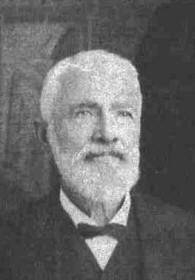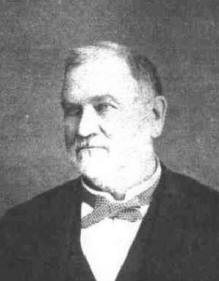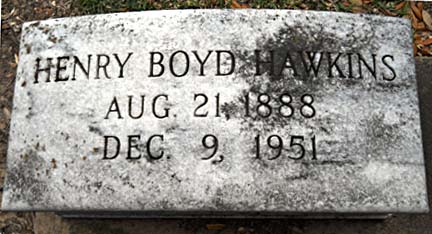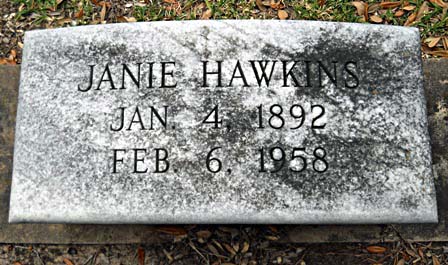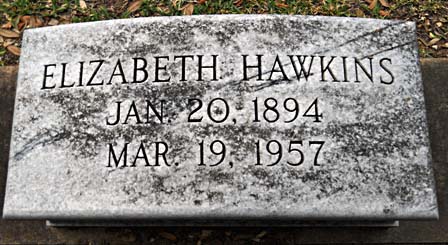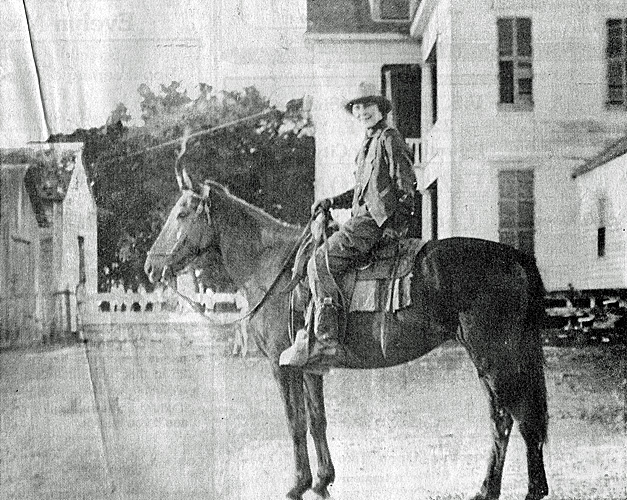|
|||||
|
Original
Hawkins Family Home |
|||||
|
|
|||||
|
Col. J. B. Hawkins has an elegant residence located in the midst of a 30,000 acre pasture a few miles further on the Matagorda road. It is surrounded by a charming grove of forest trees planted by the colonel, who was absent from home, on his Caney plantation. But we found the latch string on the outside, and Mr. Frank Hawkins and his charming young wife, nee Rugeley, ready to tender a kind hospitality. Col. Hawkins also has an apple orchard, now laden with fruit. Mr. Frank Hawkins has a steam yacht, on board of which he entertains his friends in excursions on Lake Austin. From the observatory above the mansion, Matagorda, sixteen miles distant, was plainly visible. Mrs. Hawkins has a penchant for poultry, and some three or four hundred answer her call for the distribution of feed. Mr. Hawkins represents the colored element as being perfectly quiet, orderly and contented.
--The Daily Tribune and
The Matagorda County Tribune, Century of Progress Edition,
Section Four,
August 26, 1937 Quoting a publication of a newspaper, The Old
Capital, published in Columbia, Texas, Saturday morning, July
14, 1888. |
|
Family of Dr. Henry Lowndes
Rugeley & Elizabeth Elmore Rugeley |
|||
|
Frank Hawkins, son of Colonel James B. Hawkins, was born on the Hawkins plantation in Matagorda County on December 18, 1849, three years after his father had moved to Texas from Mecklenburg County, North Carolina. He was the second youngest of a family of five boys and two girls. In 1887 he married Elmore Rugeley, eldest daughter of Dr. and Mrs. H. L. Rugeley. To this union five children were born: Henry Boyd, Meta, Jane, Elizabeth, and Elmore. Frank Hawkins attended Austin College, later was in a preparatory school at Frankfort-on-the-Main in Germany, and finished at Ashley College in England. He returned to Matagorda County to manage the Lake Austin Stock Ranch, and made it one of the finest ranches in the county and the state. He was very systematic and business like in his management practices, and was admired by citizens of the community. In 1898 he organized the first bank of Bay City, the Bay City Bank, which later became the Bay City Bank and Trust Company. Frank Hawkins died on February 25, 1901, in Austin, Texas. On the day of his death, the businesses in Bay City were closed to honor him. The Weekly Visitor, Bay City, dated March 1, 1901, noted: "Mr. Hawkins was very liberal and his death will bring many to a full realization of the worth of friendship like this. He was ready to help anyone worthy of help and sympathy. He was kind and sympathetic and was always free to advise and quick to help young men who had ambition to make something of themselves." Meta Hawkins married James Claire Lewis, a member of another prominent Matagorda County family. Their children were Frank Hawkins, Margaret, and James Claire, who died in infancy. Frank Hawkins Lewis married Florence Neely and they had four children: Frank, Jr., Janet, Meta, and James. Margaret Lewis married Austin Furse and they had four children: Janie, Austin III, John, and Mary. Elmore Hawkins married Esker McDonald and they had no children. Janie Hawkins was the manager of the Hawkins Ranch during her lifetime, and was respected by the community. Elizabeth Hawkins, a unique and interesting person, was known for her hospitality and generosity in entertaining the youth of the community with beautiful parties, especially on graduation from high school. The Hawkins Ranch was still operated by the family in 1984, and the home on Lake Austin continued to be the scene of many family gatherings -including the weddings of fifth generation descendants of Colonel James B. Hawkins and Ariella Alston Hawkins.
Historic Matagorda County, Volume II, page
224 |
|||
|
Business Houses Closed
The death of Mr. Hawkins was not unexpected to many friends here, yet the sad news was a shock to them, for they still hoped that relief might be had; that medical aid would be availing, and that his condition was not so serious. The announcement cast a gloom over our city and county, and the respect shown his memory by the business men of the city on the day of the funeral is evidence of the high esteem in which he was held by all. Deceased was born in this county on the Hawkins plantation December 18th, 1849, three years after his father, the lamented Col. James B. Hawkins, had moved to Texas from Mecklenburg County, North Carolina. He was second youngest of a family of five boys and two girls, only one of which survive him, Mrs. E. G. Brodie of Henderson, N. C. In 1887 he was married to Miss Elmore Rugeley, eldest daughter of Dr. and Mrs. H. L. Rugeley, who died in 1896. To this union five children were born, all of whom survive him. After a course of study in the schools of Germany, he engaged in stock raising for which he had a natural inclination and together with his father purchased the Lake Austin ranch, one of the most expensive as well as highly improved in the coast section, and which he followed up to the time of his death. In all of his business undertakings he was successful, conservative and cautious, but when once fully decided on a course could not be swerved. He was president of the Bay City Bank, which was organized in 1898, and which, like all of his other business ventures was proving highly satisfactory to him, and in which he took especial pride, which is best proven by the provision he had made that the institution should go on in case of his death just as during his lifetime, with no diminution of capital or responsibility. Mr. Hawkins was very liberal and his death will bring many to a full realization of the worth of friendship like his. He was ready to help anyone worthy of help and sympathy. He was kind and sympathetic and was always free to advise and quick to help young men who had ambition to make something of themselves. Indeed is his death a heavy blow to his aged mother, who herself has been lying at death’s door for sometime. She couldn’t understand why her son came not to see her, she not knowing his condition, which was kept from her. Of all her trials and affliction this is the most severe. The remains, in charge of Dr. H. L. Rugeley, who accompanied deceased on his visit to Austin, arrived at Van Vleck on Tuesday afternoon where they were met by members of the Knights of Pythias lodge and conveyed to the Cookenboo hotel where they remained until Wednesday afternoon and then interred in the family burying grounds near that place, resting by the side of his wife. The ceremonies were conducted by the Knights of Pythias and were very beautiful, at the close of which Rev. Day offered a very touching prayer. The greater portion of our citizens attended the funeral services, all business being suspended from 12 o’clock until after the ceremonies. The Visitor extends to the family condolence. The keenness of their loss is fully appreciated and felt by the people of our whole county. A light has gone out. In Memory of Frank Hawkins “Feb. 25th, 1901.—Mr. Frank Hawkins died at 8:30 this morning.” None but the recipients of such cruel messages can realize the poverty of the English language. No word to soften or mitigate; no word of coming back; no word of hope; just the cold, cruel words, “died at 8:30 this morning.” Ah! The bitterness of it! But it is sadly true. The good citizen, the devoted father, the faithful friend, is gone to come no more. The hand so readily extended in the cordial clasp of friendship is now cold and pulseless. The features erstwhile glowing with geniality, now wear the majestic dignity of death. Why is it so? Who can solve the mystery of life or death? Love mourns for answer and Faith beats her wings against the questions as ‘gainst prison bars. The shuttle lies idle. Warp and wool with its strange intermingling of sunshine and shadow, human frailties and Godlike virtues have come to an end. He who dares may take the standard of a gentleman and measure the web of his life. A Friend. Bay City, Feb. 26, 1901
The Weekly Visitor, March 1, 1901 |
|||
|
Bay City, Matagorda Co., Tex., April 7.—Died on Saturday, April 4, Elmore, wife of Mr. Frank Hawkins, aged 29 years. Mrs. Elmore Hawkins Matagorda, Tex., April 6.—Died at Lake Austin, sixteen miles east of Matagorda, on April 4, Mrs. Elmore Hawkins.
Galveston Daily News,
April 9, 1896 |
|||
|
|||
|
|||
Funeral Services Thursday For Mrs. Elizabeth Hawkins Funeral services will be from Taylor Bros Funeral Home Thursday morning at 10 for Mrs. Elizabeth Hawkins. The Rev. Aubrey C. Maxted of the St. Mark’s Episcopal Church will officiate. Mrs. Hawkins, a life long resident of Matagorda County, succumbed to an extended illness at St. Luke’s Hospital in Houston Tuesday at noon. She is survived by three sisters, Mrs. J. C. Lewis, Mrs. Esker McDonald and Miss Janie Hawkins of Bay City. Pallbearers are Wade and Wyatt Ashcraft, Billy Penny, Charles Cobb, Frank Montague, Dick Bachman, Frank Hawkins and Henry Rugeley.
Daily Tribune,
March 20, 1957 |
|||
|
|
|
|
|
Editor’s note: The following article, compiled through the efforts of Frank Lewis, Jr., recounts the accomplishments of an early day Matagorda County cattlewoman, Janie Hawkins. Other such Texas pioneer cattlewomen will be featured this weekend at Keye Ingram Auditorium in an Institute of Texan Cultures exhibit entitled “Ranch Women.” Janie Hawkins, a life-long resident of Matagorda County, spent portions of four decades managing the Hawkins Ranch and kept an eye on the operation until she died in 1958. She was the daughter of Frank and Elmore Rugeley Hawkins. Both James Boyd Hawkins and John Rugeley, her grandfathers, settled on Caney Creek in the early 1840s. They were listed on the 1840 and 1850 censuses as planters and ran large plantations, growing cotton, corn, and sugar cane—the major crop in the early days of agriculture in the county. After the Civil War, the Hawkins family tried to grow sugar cane with the use of convict labor, but since the demand for cattle was growing and they had land more suited for cattle than farming on Lake Austin, they slowly moved into the ranching business. Janie Hawkins’ parents died when she and her three sisters and brother were at a young age. They lived with her maternal grandparents Henry L. and Elizabeth Rugeley. Upon completing private school she attended Key Kidd College with her sister Meta. Once the Hawkins children reached adulthood they began the job of managing their property, forming a partnership to combine the property into the Hawkins Ranch. Janie managed the ranching operation and sisters Meta and Elmore managed the farming operation. One of the first decisions Janie made was to introduce Brahman bulls into the cattle operations. Some of the bulls came from the Pierce Estate and others came from J. D. Hudgins. Like on many ranches Janie had a foreman who ran the day-to-day operations, but she was there almost every day to see that everything ran smoothly. If she needed some extra ranch hands, the foreman would usually hire some of the tenant farmers or members of their family to help do whatever was needed at the time. Since there were fewer roads in the county and fewer trucks and trailers to haul cattle, demand was high for horses on the ranch to tend the cattle. Janie had to keep a herd of horses to supply the ranch hands when they worked the cattle. One year, Janie took a trip to New York City to watch a rodeo there. While there, she was put in the spotlight and introduced to the rodeo fans as being the supplier of the calves in the calf roping event and the bulls in the bull riding event. She was interviewed by J. C. Marr for his University of Texas thesis on Matagorda County in 1927. The subject of ranching probably did not come up in the interview, but she did have a part in preserving some of the county’s history.
Daily Tribune,
Monday, February 26, 1990 |
